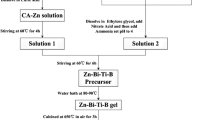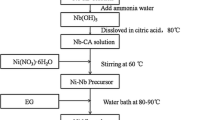Abstract
Medium-temperature sintering X8R ceramics were fabricated based on BaTiO3-based ceramics with Bi2O3 additives. The effects of sintering aids Bi2O3 on crystalline structure and electrical properties of BaTiO3-based ceramics were investigated. The sinterability of BaTiO3 ceramics was significantly improved by adding Bi2O3, whose densification sintering temperature reduced from 1,260 to 1,130 °C. However, the dielectric constant (ε) of BaTiO3-based ceramics doped with Bi2O3 was decreased dramatically. Both low ε phase Bi4Ti3O12 and the decrease of the tetragonality (c/a ratio), which are demonstrated by XRD pattern, are resulted in the decrease of ε. The ε of samples doped with 5.5 wt% Bi2O3 was higher than the other doped samples. The substitution of Bi3+ for the Ba2+ in BaTiO3 resulted in the increase of electrovalence (from +2 to +3) of A-site ion, so the attractive force between A and B (Ti4+) sites becomes stronger. Thus Ti4+’s polarization enhances, then ε was increased to some extent. The X8R BaTiO3-based ceramics could be sintered at as low as 1,130 °C by doping 5.5 wt% Bi2O3 additives into the BaTiO3-based ceramics, with a ε greater than 2,430 at 25 °C, dielectric loss lower than 1.3 % and temperature coefficient of capacitance <±15 % (−55–150 °C).




Similar content being viewed by others
Notes
The list of the parameters of G (in SI units, T in kelvin) used in the calculations. For BaTiO3: α1(T) = 4.124 × 105(T − 118)Jm/C2; α11(T) = −2.097 × 108Jm5/C4; α111(T) = 1.294 × 109Jm9/C6; Q12 = −0.043 m4/C2; Q11 = 0.1024 m4/C2.
References
G.-H. Chen, Mater. Sci. Mater. Electron. (2012). doi:10.1007/s10854-012-0710-0
N. Ma, J. Electroceram. 28(4), 275 (2012)
K. Yan, J. Am. Ceram. Soc. 93(11), 3823 (2010)
H. Naghib-zadeh, J. Eur. Ceram. Soc. 3(1), 31 (2010)
L. Zhou, J. Eur. Ceram. Soc. 21(4), 531 (2001)
H. Beltrán, J. Electroceram. 18, 277 (2007)
L. Zhou, J. Am. Ceram. Soc. 82(4), 1064 (1999)
Y. Li, J. Wuhan Univ. Technol. Mater. Sci. Edit. 23, 143 (2008)
T.A. Jain, J. Eur. Ceram. Soc. 29, 2595 (2009)
K.Y.J. Yang, Alloys Compd. 458, 415 (2008)
S. Wang, Mater. Sci. Mater. Electron. 21, 1159 (2010)
Acknowledgments
This work was supported by the Science and Technology Development Foundation Project of Tianjin Higher Education (under Grant 20100712) and the National Natural Science Foundation of China (under Grant 51102076). We also acknowledge the Science and Technology Development Foundation Project of Tianjin Higher Education (under Grant 20110710) and Youth Teacher Plan by CSC.
Author information
Authors and Affiliations
Corresponding author
Rights and permissions
About this article
Cite this article
Wang, S., He, H. & Su, H. Effect of Bi2O3 doping on the dielectric properties of medium-temperature sintering BaTiO3-based X8R ceramics. J Mater Sci: Mater Electron 24, 2385–2389 (2013). https://doi.org/10.1007/s10854-013-1106-5
Received:
Accepted:
Published:
Issue Date:
DOI: https://doi.org/10.1007/s10854-013-1106-5




